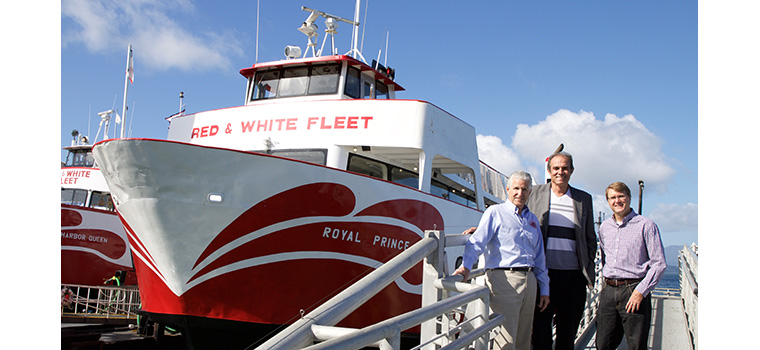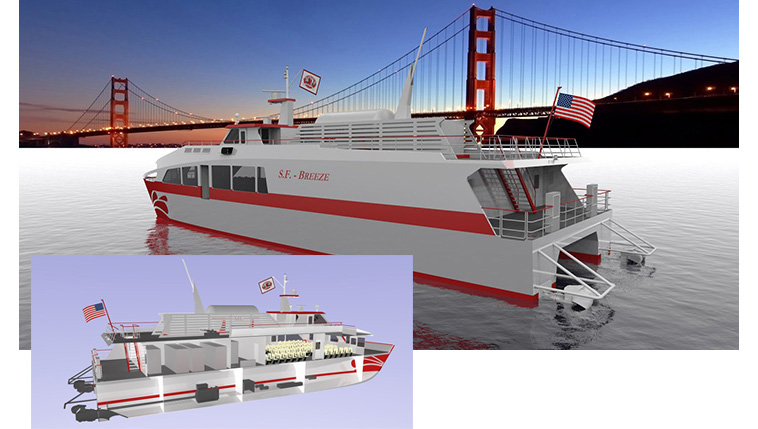The notion of a high-speed, zero-emission passenger ferry has been dismissed by some as science fiction.

From left to right: Tom Escher, president of Red & White Fleet with Sandia National Laboratories researchers Lennie Klebanoff and Joe Pratt. Photo by Michael Padilla, Sandia National Laboratories.
By Bill Picture
Published: March, 2017
The notion of a high-speed, zero-emission passenger ferry has been dismissed by some as science fiction. But the prospects for hydrogen-powered clean ferries are now looking up, buoyed by a recent feasibility study and the support of Red and White Fleet, one of the Bay Area’s ferry operators.
Smaller hydrogen-powered ferries for short trips already exist, but there were doubts about whether the technology could be exploited in a way that would permit large-scale, fast service over longer distances. According to a feasibility study completed last fall by Sandia National Laboratories, however, hydrogen fuel cells can generate the power needed to move a fully-loaded passenger ferry across the San Francisco Bay—and they can do so without sacrificing speed or impacting the region’s air quality.
The researchers’ specifications: a 150-passenger commuter ferry that would travel four 50-mile round-trip routes each day at a top speed of 35 knots (roughly 39 miles per hour) about 60 percent of the time. The ferry could refuel midday, between the morning and afternoon commutes.
“This kind of boat has never been built before,” said mechanical engineer Curt Leffers, one of the project managers. “Hydrogen fuel cells are heavier than diesel engines for a given power output, so achieving the right power-to-weight ratio for the vessel was tricky.”
The need for speed drove the design to a slightly longer catamaran. The engineers were able to save weight by consolidating the support equipment for the fuel cells. To achieve the necessary safety standoffs from the fuel cells, the designers placed the fuel cells on the main deck of the vessel in a separate compartment. The researchers explained that this provides physical separation between the fuel cells and passengers.
Ten rigorous criteria were used to gauge the feasibility of this hypothetical vessel, a design dubbed the “SF-BREEZE”—an acronym for San Francisco Bay Renewable Energy Electric Vessel with Zero Emissions. By all accounts, the vessel passed each test with flying colors.
“SF-BREEZE sailed through them all,” Sandia researcher Lennie Klebanoff told reporters last year.
The project’s stakeholder team—including the Department of Transportation’s Maritime Administration (MARAD), the American Bureau of Shipping, the U.S. Coast Guard, the Port of San Francisco and Red and White Fleet—strongly believed they were onto something from the start. Now after briefly celebrating the success of the feasibility study, the partners are back in the lab fine-tuning the vessel they imagined two years ago and subjected to evaluation during the study.
“Now Sandia and MARAD are optimizing the boat, looking at the findings to figure out what makes the most economic sense,” said Tom Escher, owner of Red and White Fleet. “Which is better—an 800-passenger ferry that goes 15 knots or a 600-passenger ferry that goes 22 knots? We don’t know yet. Maybe for shorter runs, an all-electric boat is better. These are the things we need to figure out before we can move forward.”
Escher expects to have these answers soon. “A follow-up report should be out in the next two months,” he said. “And that report will basically say, ‘We took the original findings, applied them, tried all the different variables we could think of; and from an economic point of view, this is the boat we recommend.’”
Unlikely beginnings
Escher was the first to come up with the idea for this iteration of a green ferry—even though the cost of adding a hydrogen-powered ferry to his fleet, aside from expected subsidies, will come largely out of Red and White’s pocket. After all, a hydrogen-powered ferry is estimated to cost roughly twice as much to build as a traditional diesel-burning ferry, coming in between $20 million and $30 million.
But Escher said he’s concerned enough by recent findings related to the impact of transportation-related pollution to search for ways to apply emerging green technologies to his own industry. While it’s hard to determine exactly how big of a slice of the Bay Area’s smog pie can be attributed directly to ferry service, logic dictates that the impact of the diesel-burning vessels, which carry a reported 5,000,000 ferry riders each year, is significant enough to warrant Escher’s concern.
Escher pointed to a 2013 study conducted by the Massachusetts Institute of Technology that showed some 53,000 Americans die each year as a result of transportation-related air pollution. That’s 145 people each day, or six every hour.
“Ferry operator or not, business owner or not, we all breathe the same crap, right?” he said. “And what this will do is remove all those nasty greenhouse gases from ferry exhaust.”
San Francisco has already agreed to make space at Pier 54 available to an energy provider for the installation of a hydrogen fueling station. Late last month, the Examiner reported that two applicants were being considered. While the fueling station’s primary customers will be the owners of hydrogen-powered cars—every major car maker is expected to have a hydrogen-fuel-cell-powered model within the next five years—a simple modification will allow ferry operators to use the same station for fueling their vessels.
It’s important to note that the hydrogen itself is derived from renewable sources such as wind or solar.
Fear of the unfamiliar
The version of SF-BREEZE featured in the initial study was made entirely of off-the-shelf components that could be purchased from the Internet. Escher expects the final version also to include Amazon-able components. Where he foresees the most variance is with pricing.
“The pricing in the original study is already off,” he said. “The batteries have gotten cheaper in the last two years. They’ve also gotten lighter and more efficient.”
With every week that passes, Escher said his idea for a clean-running ferry gets more and more feasible. Stakeholders are also excited about the changes that SF-BREEZE promises in terms of promoting renewable fuel sources and creating jobs. The objections voiced thus far, Escher says, have been rooted in a lack of understanding.
“I get it,” he said. “If you’re like me and you have trouble just using your iPhone, this is a tough thing to wrap your head around. But like it or not, it’s happening. It’s like those people who didn’t understand what Henry Ford was doing, and called him a nut. Look what happened with that. Not that I’m comparing myself to Henry Ford. This is not about me or Red and White Fleet. This is about the environment, and doing something that will benefit everyone.”
Among the list of supporters that Escher makes sure to thank on behalf of his team are Governor Jerry Brown, San Francisco Mayor Ed Lee and the California Air Resources Board. “They get that this is a game-changer,” he says. “And it’s just the beginning. This will have a major impact on every shipyard in the country, mark my words.”

Tom Escher, owner of Red & White Fleet, said that his idea for a clean-running hydrogen fueled ferry is getting more and more feasible. The drawings on this page are based on an engineering model and were provided by Sandia National Laboratories.

Sandia National Laboratories

